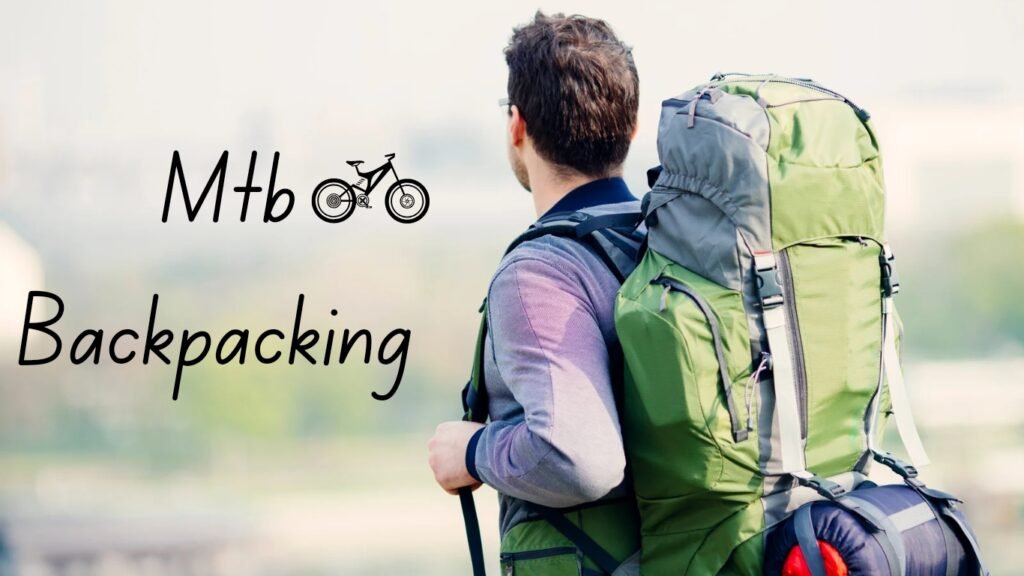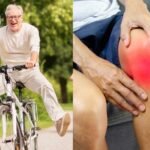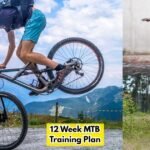Mountain Bike Backpacking is one of the best sports and a hobby that can give you a lasting experience.
Because when you combine endurance biking and camping, it pushes you mentally, physically, and emotionally.
As a mountain biker, you will ride a mtb through various trails and experience beautiful views. And being a backpacker or a camper, you will witness how beautiful nature is.
In this guide about mountain bike backpacking, we will discuss the best trails in the U.S, how you can prepare your bike for rocky trails, what gears are important that you will need for backpacking as a biker, how you will prepare yourself mentally and physically for the Rockies, safety tips, and too many more things.
What is Mountain Bike Backpacking, and Why Try It?

Mountain Bike Backpacking involves two activities: Biking and camping. And when you combine these two things together, it becomes an epic adventure.
Through your bike, you will enjoy many challenging trails, carrying your own gear for camping along the way.
Basically, you will rely on your own reliance and skills to survive and thrive.
Why Should You Try It?
There are three reasons why you need to try Mountain Bike Backpacking.
The Ultimate Freedom:
When you’re backpacking on a bike, that means you can cover more area on an MTB or a trail bike than you would cover when you do hiking barefoot.
Besides this, Mountain Bike Backpacking will also help you escape the noise from your daily life and take a break to spend time with nature.
Challenge Yourself:
Mountain Bike Backpacking is an adventurous hobby and sport. That’s why you will face grueling climbs, technical descent, and unpredictable weather conditions.
On the other hand, as a backpacker, you will be carrying loads on the bike. In other words, you will challenge yourself to live sustainability like a nomad.
Bond with Nature:
As a camper or a backpacker, you will see sunrises, sunsets, birds singing songs, and many beautiful voices.
Why Choose the Rockies for Mountain Bike Backpacking?
These are MTB routes available over 3,000 miles, with different types of trails, including gravel paths, technical single tracks, and high altitudes. It mixes both ascents and descents trails.
Most trails are suitable for all types of riders, including beginners, intermediates, and pros.
There are three main reasons why you need to try mountain biking and backpacking.
The number one is enjoying the breathtaking scenery, and the second is wildlife encounters.
Breathtaking Scenery
When you go biking in the Rockies, you will go through glacial lakes, sprawling meadows, dense forests, etc. It will look very beautiful.
Wildlife Encounters
You will also encounter wildlife such as elk, deer, mountain goats, black bears, etc., depending on where you are riding your bike.
Trust me, these encounters will give you lasting memories, especially when you spot a big animal like a bear. Some people have even spotted a giraffe during an MTB ride.
Remote Solitude
Some trails are located in remote areas where there will be no cars, no crowds, and no other restrictions. Only you and your bike will be there.
Also read: Safety Tips for Riding a MTB in a Remote Areas
Preparing Your Bike for the Rockies
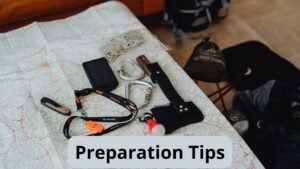
You and your bike will face a little more extra stress when you combine a backpacking trip with the bike.
Therefore, preparation is very important to make the trip enjoyable and memorable rather than a stressful experience.
Choose the Right Bike
If you have multiple mountain bikes, such as full suspension and hardtails, or a different one specifically designed for your ride, you want to choose one depending on your route (Trails where you’ll ride).
However, generally, a full-suspension bike is good for rough and technical trails as it provides balance on a trail with lots of rocks and roots.
On the other hand, a hardtail bike is for smoother trails.
So, it depends on where you are going to ride and camp. If it’s a mountain, then you can go on a full-suspension bike.
Also read: 10 Types lf mountain bike for different trails
Optimize Your Suspension
You need to adjust the suspension to handle the extra weight of your gear. Because you are going camping or backpacking, you will carry the extra load.
Upgrade Your Tires
You can use tubeless tires because they are less likely to get punctured.
If you have tube tires, you may need to carry extra tools to fix a puncture. And, of course, a pump to fill the air. (How to fix flat tires of your MTB)
Por tip: It’s better to choose a tire with aggressive tread for a better grip on rocky trails. Besides this, don’t forget to increase the air pressure so that you can maintain your bike.
Check Your Brakes
You also want to make sure that your hydraulic disc brakes are working properly.
Because you will need them frequently used in steep descents.
Here are a few more essential tools you will need:
- A multi-tool with a chain breaker.
- Two spare tubes (even if you’re running tubeless).
- Tire plugs and a patch kit.
- Spare brake pads and derailleur hanger.
Also read: How to do Regular Maintenance of Your Mountain Bike at Home
Top Trails for Mountain Bike Backpacking in the Rockies

You can visit many of the best trails in the United States, Canada, and Europe. Twenty-seven of them are best for MTB.
However, there are four top trails in the United States and Canada that you can visit to backpack in the Rockies.
Also read: How to find Local Mountain bike trails near you
The Colorado Trail (CT)
- Length: It’s 486 miles long, but it can be broken into two sections.
- Terrain: A mix of high-alpine singletrack, rocky descents, and forested paths.
Highlights: You’ll get the view of breathtaking mountain passes and remote wilderness.
Pro Tip: You can carry extra jackets for high-altitude sections where the temperature can get too chilly. (Mountain biking clothes for women, men and Kids)
Whitefish Divide Trail (Montana)
- Length: It’s between 60 to 80 miles.
- Terrain: A mix of flowy singletrack and rugged forest roads.
Highlights: beautiful views of Glacier National Park.
Pro Tip: You need to carry bear spray as this area is prime grizzly country.
Also read: Best family friendly mountain bike trails in USA to visit with your kids and other people
Kenosha Pass to Breckenridge (Colorado)
- Length: It covers over 32 miles.
- Terrain: Gentle climbs and steep descents with beautiful views.
Highlights: You’ll see prime fall foliage, which will give you unforgettable memories.
Banff to Fernie (Canada)
- Length: 200 miles.
- Terrain: Gravel roads, alpine trails, and scenic valley routes.
Highlights: Postcard-perfect views of the Canadian Rockies.
Pro Tip: You should stop in Fernie for some of the best local food and craft beer in the Rockies!
Also read:
- How to plan a mountain bike trip to Europe
- Sedona Mountain biking review & Why Should You Ride there
Packing Smart: Gear Essentials for Bikepacking
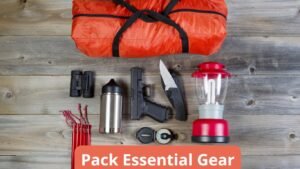
Once you have decided the place where you want to go for camping and have prepared your bike for bike, now it’s time to pack.
Shelter and Sleeping: Your Portable Home
Tent or Bivy:
If you are making a multi-day trip, then you will need a lightweight house, or in other words, a tent or Bivy.
Many backpackers prefer the MSR Hubba Hubba NX tent because it’s easy to pack due to its small size, plus it can handle various weather conditions.
Besides this, as a solo backpacker, you can also go with this Nemo Hornet light or a Bivy sack like the Outdoor Research Helium Bivy.
They are lightweight and good for short trips for a solo person.
Most importantly, you wanna set up the tent before you leave the home, check for any damage and make sure everything is fine.
Sleeping Bag:
If the temperature where you want to camp is around 20 degrees Fahrenheit, then you’ll need a sleeping bag.
You can choose the Western mountaineering ultralite. It’s an ultralight sleeping bag.
But make sure your sleeping bag has a liner to add extra warmth and keep your bed clean for multi-day trips.
Sleeping Pad:
You can carry the NeoAir XTherm sleeping pad if you want to sleep more comfortably. It is a good sleeping pad because of its quality and lightweight.
Also read: How to Fly With Your Mountain Bike in an Airplane
Clothing: Be Ready for All Conditions
In the mountain region, the weather changes too frequently. That’s why you need to pack some extra layers.
Base Layers: You can have it for moisture-wicking merino wool or a synthetic material. Mariana wool is great for resisting odour and staying warm in wet environments.
Insulation: You can have a light jacket light, like a Patagonia micro hoody, to wear during the evening when the temperature is plummeting.
Outer Layer: You want to make sure that your outer layer is waterproof and breathable.
It will help in rainy conditions. You can go with the Arc’teryx Beta LT jacket as they offer good weather protection and are lightweight, too.
Riding Clothes: For riding, you can consider having padded shorts and a moisture-wicking jersey for comfortable long rides.
You can carry an extra pair of shorts for multi-day trips.
Gloves and Accessories: Lightweight gloves are really important. Make sure you carry them to protect your hands from bushes, falls, and, most importantly, weather.
However, if you know the place is cold where you will camp, make sure your gloves are heavier. Plus, you can also carry things like a buff or neck gaiter and a warm beanie.
Food and Cooking: Fueling Your Adventure
Energy is everything when bike-packing, so plan meals and snacks that are lightweight, high-calorie, and easy to prepare.
Compact Stove:
For multi-day tips, how can we neglect cooking and eating?
So, you want to plan meals and snacks that are lightweight and high in calories because you will burn a lot of fat.
You will need to have a backpacking stove like JetBoil Flash. It’s good for boiling water within 2 minutes. Plus it’s light fuel canisters.
Pro Tip: Always need to carry more fuel than you think you will need. Because in the mountains, wind can change everything so dramatically.
Meals:
Dehydrated meals like backpackers’ pantries or mountain houses are very important as they are lightweight and calorie-dense, and you will only need hot water to prepare them.
So that’s why you can pack at least two meals per day plus some extras for an emergency.
Snacks:
You can carry some healthy snacks like chickpeas, energy bars, dry mix, and nuts with butter packets for extra energy, especially for a longer ride.
Besides this, you can also take small packets of dried fruits to sustain energy.
I suggest you avoid sweet snacks and salty foods because they will make you feel more thirsty and also not really good for your health.
Water Filtration:
You will need a lot of water when you are specifically riding in the Rockies because, during peak days, the air can dry.
So make sure to carry a reliable water filter like Sawyer Squeeze or Katadyn BeFree.
On the other hand, many trails also have streams and decks, but I still want you to check the map and confirm if the water is available or not.
But most importantly, you always want to carry extra water bottles for an emergency.
Tools and Spare Parts: Your Lifesavers on the Trail
When you are on a multiple-day mountain bike backpacking trip, Carrying extra tools and spare parts is important to keep the momentum going.
Nobody knows when the bike gets punctured or if there is any other issue.
So here are some things that you will need to consider.
Multi-tool with Chain Breaker: A compact multi-tool with hex wrenches, screwdrivers, and a chain breaker, such as the Crankbrothers M19, is really important so that you can repair your bike quickly.
Spare Tubes: If you’re riding with tube tires, then you will need to carry two tubes, although it’s good to have an extra tube if you’re running tubeless. Punctures are normal, so you’ll need a backup plan.
Tyre Repair Kit: It’s really important to Include plugs, a patch kit, and a pump or CO2 inflator.
Brake Pads: For steep descents, you can wear out pads quickly, so bring an extra set.
Derailleur Hanger: A Rockie trail ride can also be a little risky; even if it’s not, I still recommend you to carry a medkit, at least bandages for protection, because you may get scratches and bruises after a fall or pass through dense forest.
Also read: 18 Common Mountain biking injuries and how to prevent them
Physical and Mental Preparation for the Rockies

For mountain biking or backpacking, you need to prepare mentally and physically, and for that, you can do some basic training.
Physical Training: Build Your Stamina and Strength
When you want to ride your bike on rocky areas, you will need endurance and strength.
Plus, some mountain bike skills to handle it properly because most people can not handle it when the bike is fast on grueling climbs and technical descents.
Before going on a ride, you want to do some cardio training to prepare yourself physically.
So, you find a place near your home where you can mimic the rockies trails and build stamina.
You can also do strength training for Mountain Biking. Some of the best exercises that I suggest you do are squats, lunges, deadlifts, etc. These exercises build strength.
Furthermore, you also need to build a strong core through mtb exercises. A Strong core will improve your balance and stability.
Most importantly, as a backpacker on a mountain bike, you can practice loaded rides.
For example, you can start carrying your gear on the bike upto (up to 20 pounds of weight) every day for a few kilometers; it will help you build a habit.
Mental Preparation: Overcome the Tough Moments
There is a famous quote by one of the greatest boxers of all time: “You Have To Have The Skill And The Will, But Will Must Be Stronger Than The Skill.”
So, as a mountain biking backpacker, you will have skills, but more importantly, you need to be mentally prepared, too, because you will rely on your own gadgets and your own stamina, through which you will cover longer routes.
So, prepare yourself mentally.
You first want to visualize success. For example, you can picture yourself going through tough climbs, setting up your camp after a long day ride, facing bears, etc.
Besides this, you have to make one thing 100% sure that you will face challenges. You will even face pain, such as muscle soreness, unstable weather conditions, sometimes rainy, sometimes chilly, etc.
So, you have to accept this and consider it as a part of your trail biking journey.
Most importantly, when you are covering a long trail, and you feel you cannot finish it in one day or in a certain limited time period. You need to break it down.
For example, you want to cover 50 km in a day, so you will cover only 25 km, then take a break, and then 15 km, then take a break, and after that 10 km, then take a break on the final mtb destination.
You just simply want to have small goals. When you think like that, your brain will not feel stressed.
Plus, you can also fuel yourself. Although it’s just an example, in your case, you can cover even 100 km, 50 km, 70 km, that’s totally up to you.
Safety Tips for Riding in the Rockies
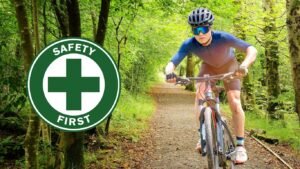
Safety is really important when you are a camper. So here are three things that you can keep in mind.
Wildlife Awareness: Stay Safe in Bear Country
Remember that you can have a close encounter with a wildlife animal, as rookies are home to black bears, grizzlies, mountain lions, and many more.
So make sure you are ready to face any of them, or maybe all if you are lucky enough.
Number one thing, you want to store enough food properly. You can also use beer canisters, or you can simply hang your food in a bag at least 10 feet off the ground and 4 feet from any tree trunk.
Plus, you want to carry a beer spray, and make sure you keep it within your reach.
For example, when you sleep, you can keep it on your right side. Or, while riding, you can keep the spray on your handlebar or hip belt.
Most importantly, I recommend you do some practice spraying before your trip.
Lastly, if you see a bear is not running away, or you are not able to use beer spray properly, you want to make a noise, call out for help, or do clapping, etc. It will help you to keep bears away from you.
Also read: How to Save Yourself from a Bear Attack
Weather Preparedness: Expect the Unexpected
In the mountains, the weather is always unexpected. So you have to be prepared for that.
You can have a waterproof jacket, warm hat, gloves, extra layers, etc.
Plus, keep tracking the forecast during the afternoon, as thunderstorms are common. So you want to finish right before noon.
You can also use applications like Alltrails or Gaia GPS to monitor the trail conditions and weather updates.
Remember, sometimes networks are not available in the mountains or Rockies region. That’s why you want to download an offline map.
You can also download the Google map, but besides this, you can download Applied Trail Forks or German Explorer.
Besides this, if you want to travel through remote areas, you can have a GPS device with an SOS feature enabled, such as Garmin InReach Mini. It’s good for riding in remote areas.
Also read: Safety tips for Mountain biking
Why Mountain Biking Changes Lives
There are many reasons why most people love backpacking or mountain biking and how it changes lives.
One of the first reasons is that it tests your limits and helps you push your limits. Plus, by doing so, you can build confidence and reliance.
Secondly, a big benefit if you do mountain biking is that you can lose a lot of weight.
Besides this, it is also good for refreshing your mind, especially when you have gone through a really stressful month.
So at the end of a stressful month, you can spend some time with nature before starting a new month,
Lastly, when you climb on rocky descent trails, this will teach you how to remain patient, and when you ride on downhill trails, it will remind you of freedom.
My own experience:
If I share my own experience with mountain biking, then for me, it’s good for my health, gives an adventurous experience while keeping me healthy, plus it refreshes my mood while spending time between nature and other beautiful places.
I sometimes even go for normal rides to eat street food on my bike.
Conclusion
Mountain biking is not just a normal trip. It includes many adventures, ups and downs, and various experiences, such as going through different types of trails, like the rocky descent, which is quite challenging.
As a backpacker, it will be very interesting to camp under the sky while interacting with the wildlife creatures.
However, to make your ride enjoyable and memorable, make sure you carry all essential mountain biking gear, like suitable clothes, and some spare parts, like extra tubes, GPS devices, etc.
Before going on the trail, you first want to decide where you want to go, then do proper research about a specific route, and then make a pre-bike guide checklist (You can use a journal or a diary) so that you don’t forget anything.
For example, you can write everything on a piece of paper about things you need for your trip, such as a type of bike, some essential MTB and camping gear, a tank, water bottles, water filters, etc.
After writing that, you have to keep all these things together, make a check mark in a diary where you have written all of these things, and make sure they are all ready for the trip.
FAQs
Here are some of the most frequently asked questions about mountain bike backpacking.
What essential gear do I need for a mountain bike backpacking trip in the Rockies?
There are many mountain biking gear for backpacking in the Rockies, such as backpacking bags, which can be a frame bag, handlebar bag, etc.
A repair kit, a GPS device for navigation, camping gear like lightweight tents, sleeping bags, etc.
Plus, you’ll also need a cooking system, such as a portable stove, cookware, water filter, extra clothes because the weather can unexpectedly change in mountainous regions, and most importantly, food and water.
If you have all these things available, you can enjoy your mountain biking trip while ensuring your safety.
Where are the best trails for mountain bike backpacking in the Rockies?
One of the most popular trail options for mountain bike backpacking is the Colorado Trail.
It’s good for backpacking, and you can enjoy stunning views and face challenging terrain there.
Besides this, the Great Divide Mountain Bike Route, also known as GDMBR, Monarch Crest Trail.
Whitefish Divide Trail, Kenosha Pass to Breckenridge of Colorado, and if you are in Canada, you can also visit Banff to Fernie.
How do I plan a mountain bike backpacking trip in the Rockies?
It is really easy to plan for a paramount enjoyable biking trip. Firstly, you want to decide your route and where you want to go based on your skill level and cylinder preference.
After this, you want to obtain permits and reservations because some areas require permits for camping, especially the ones that are popular.
Then, you want to check trail conditions and weather and create a detailed itinerary. After that, you want to pack some smart and light MTB gear.
Most importantly, when you are visiting any place, you want to inform a friend or a family member about your route and estimate the date of return, etc.

Ali is the founder of Mountain Bike Insider and an passionate rider with years of hands-on experience in mountain biking. From testing gear to exploring trails, Ali writes based on real riding knowledge to help others make smart, safe, and enjoyable biking choices. Every guide is built on research, personal use, and a passion for the sport.

